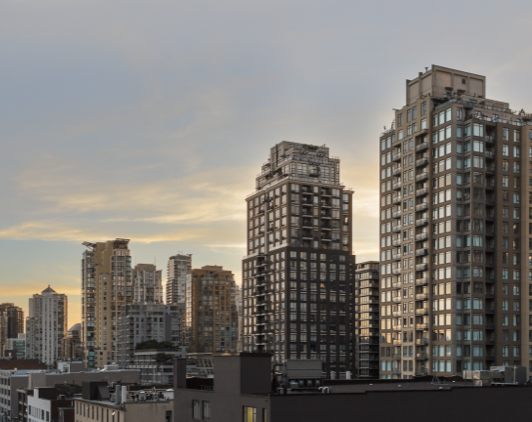Buying a condo in Yaletown? Here’s what you need to know when reviewing strata documents.
Buyers should review the strata documents carefully, paying particular attention to the strata bylaws, rules, financial statements, insurance coverage, minutes of strata meetings, and engineering or building reports. These documents can provide important information about the building’s maintenance, repair history, and operating costs, as well as any restrictions or obligations that come with ownership.
What is Strata Corporation?
A strata corporation is a legal entity created to manage and maintain a shared property or building, such as a condominium or townhouse complex. Each owner of a unit within the property is a member of the strata corporation and has a say in its decision-making processes. The corporation is responsible for things like maintaining common areas, enforcing bylaws and rules, and managing finances.
What is Strata Council?
In Vancouver, strata councils are responsible for managing and maintaining shared property in strata-titled buildings. They are made up of elected owners who make decisions on behalf of the strata corporation.
What is a Strata Lot?
A strata lot in a building refers to a privately owned unit within a larger building or complex. These units are typically defined by a boundary that separates them from other units and common areas, and are often subject to strata bylaws and regulations. Strata lot owners are responsible for maintaining and repairing their units, while common areas are maintained by the strata corporation.
Limited Common Property:
The Strata Property Act defines Limited Common Property in strata refers to areas or elements of a strata property that are designated for the exclusive use of certain unit owners, but are still considered part of the common property. In Vancouver, this typically includes things like balconies, patios, or parking spaces that are attached to specific units.
Common Property
In British Columbia, common property in a strata refers to the areas or facilities within a strata development that are owned or used jointly by all unit owners. This may include amenities such as elevators, hallways, and recreational facilities. The responsibility for maintaining and repairing common property is shared among all unit owners and is typically managed by the strata corporation.
Here is a quick summary of what Strata Document package should consist of and what these documents mean:
Building Insurance Policy and Your Home Insurance, more on this here
There are so many aspects of coverage to a home insurance policy. From the physical home structure to coverages that protect you even when you aren’t at home. Your home insurance will cover the damage to your home from any risks outlined in your policy to ensure that you’re able to get back to normal as quickly as possible. A few of the risks discussed in a policy include fire, water damage, wind, theft, and vandalism. The building insurance is paid for by the Strata Corporation. However, it is home owner’s responsibility to have contents protected and you should arrange your own insurance coverage at your earliest convenience. Some Yaletown buildings will have deductibles as high as $250,000, make sure you have that covered within your home insurance.
Bylaws:
Bylaws in strata in BC are rules and regulations that govern the conduct of strata owners, tenants, and occupants. They cover a wide range of topics, such as noise, pets, parking, and maintenance of common areas. Bylaws are legally binding and must be followed by all members of the strata community. Some Yaletown buildings will allow short term rentals and some will allow minimum 1 year lease – all of this is specified in the bylaws. More on the bylaws here.
Form B:
The purpose of Form B is to provide transparency and ensure that potential buyers have access to important information before purchasing a strata lot. This form includes key details such as the strata lot number, unit’s monthly strata fees, amount in building’s contingency fund, parking and storage numbers, and any registered interests or charges against the strata lot.
Annual General Meetings (AGM) /Special General Meetings (SGM):
Every strata corporation is required to hold an annual general meeting (AGM) once a year. The purpose of the AGM is to allow shareholders to review the corporation’s financial statements, elect council, and discuss any other business that may arise. AGMs must be held within 15 months of the previous meeting and at a location within the province. The meeting can be held in person or virtually. Additionally, corporations can hold special general meetings if necessary to address and plan projects or matters.
Meeting Minutes:
Usually held once a month, these meetings provide an opportunity for owners to discuss and make decisions on matters related to the building, such as maintenance and repairs, financial management, and bylaw enforcement. When reviewing strata meeting minutes, it’s important to look for any decisions made by the strata council, any actions taken, any financial updates, any upcoming maintenance or repair plans, and any updates on strata bylaws or rules. If a Yaletown building is smaller, meetings might be held every two to three months instead of every month.
Depreciation Report:
A depreciation report provides a comprehensive inventory of the common property and assets of the corporation, their current condition, and a forecast of their expected useful life. This report helps strata corporations plan and budget for future repairs, maintenance, and replacement costs, which can help prevent unexpected expenses and special assessments. It also helps ensure that the strata corporation is fulfilling its obligation to maintain and repair common property in a timely and cost-effective manner.
Yaletown is an upscale neighbourhood in Vancouver, known for its historic buildings that have been converted into trendy lofts and apartments. Some of the buildings in Yaletown are characterized by their brick facades, large windows, and industrial design elements, which reflect the neighbourhood’s history as a former warehouse and rail yard district. Overall, the architecture in Yaletown is a unique blend of old and new, creating a vibrant and dynamic urban environment. It is important to review building details to know what is coming up in terms of maintenance.
Browse all Yaletown Homes for Sale HERE
Reach out to chat about your well-maintained buildings in Yaletown! hello@liveyaletown.com

